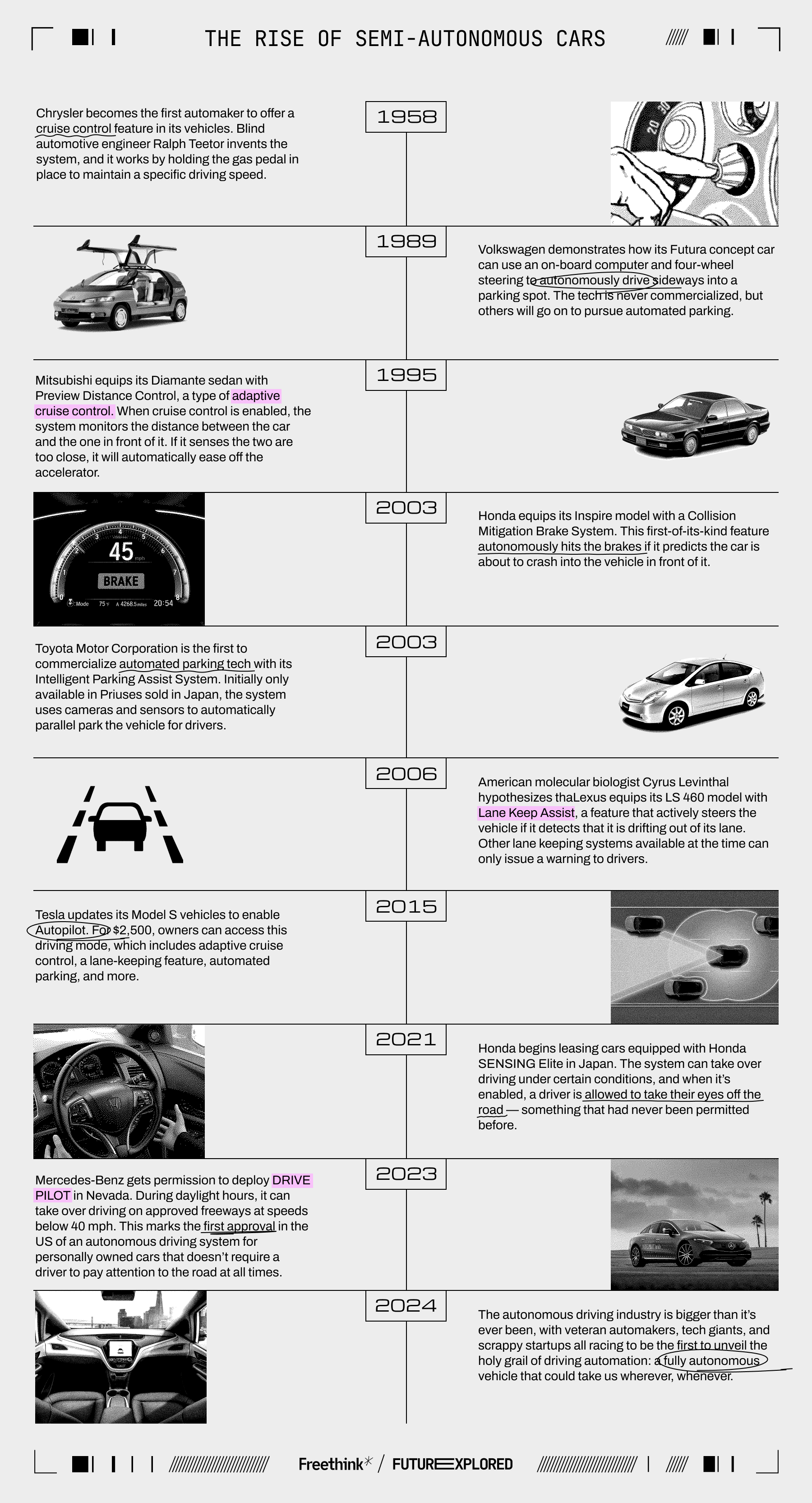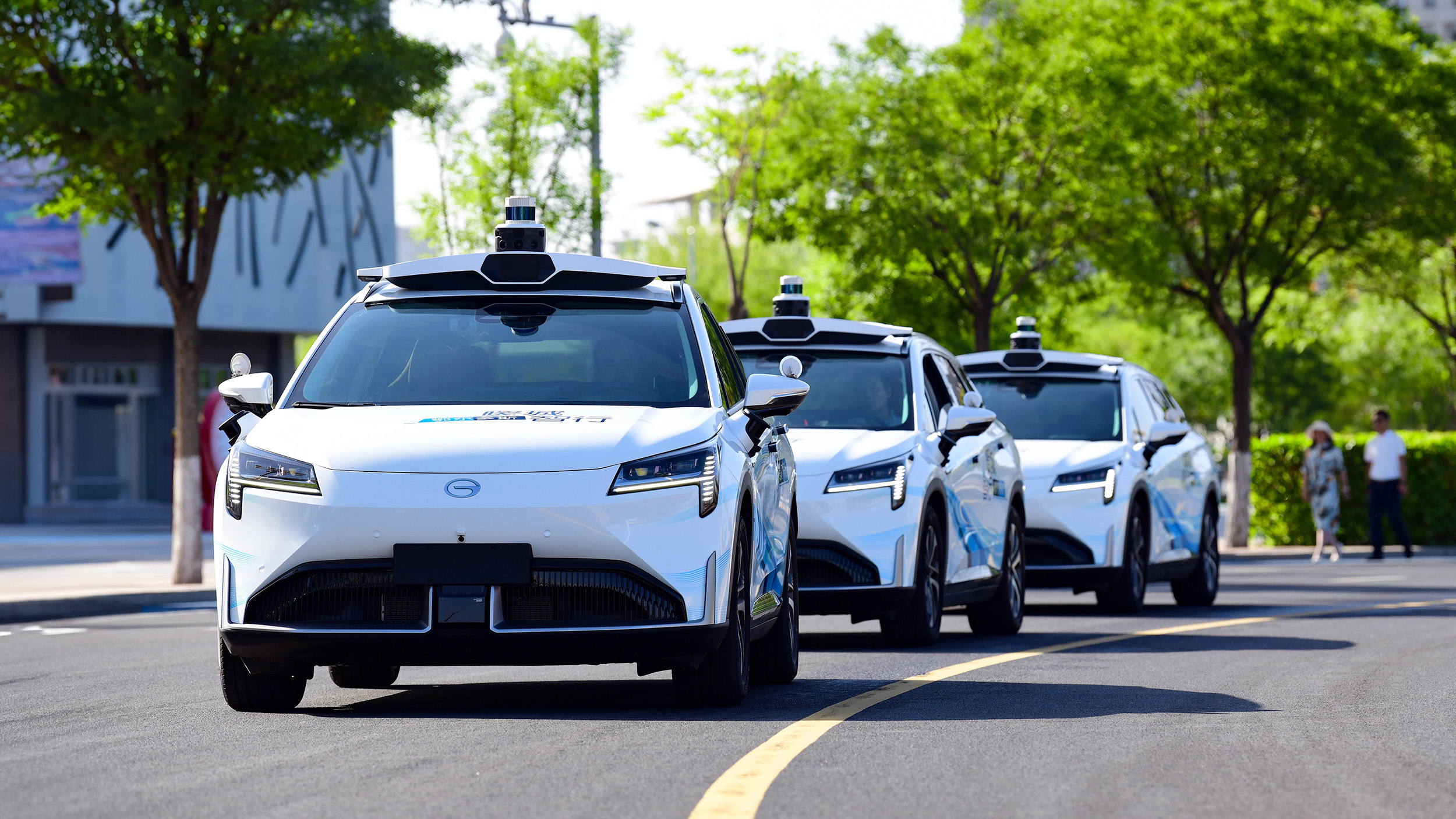The rise of the semi-autonomous car

- The promise of autonomous vehicles is that they will make our roaders safer by removing human error.
- While no one knows when, or if, fully autonomous vehicles will arrive, more capable semi-autonomous vehicles will be deployed in the coming years.
- From automatic braking to adaptive cruise control and smart parking, we look at the automated features looking to make driving safer and less stressful.
This article is an installment of Future Explored, Freethink’s weekly guide to world-changing technology. You can get stories like this one straight to your inbox every Saturday morning by subscribing above.
It’s 2030, and you just drove your new car home from the lot. Well, technically, it did most of the driving. We’re still waiting for someone to build a fully autonomous car, which you can own and drive anywhere, but almost every new car is now semi-autonomous, with features that are making our roads safer and driving less of a hassle.
Smarter “dumb” cars
While some people relish their time behind the wheel, driving is an annoying necessity for most, a time suck that takes attention away from the long list of things they’d rather be doing than wondering if that guy actually plans to enter their lane or just forgot his turn signal is on.
Right now, our only option may be to buckle up and suck it up, but advances in autonomous driving technology could not only minimize the hassle and stress of driving, but also make our roads safer by removing some human error from the driving equation.
To find out more about this new era in transportation, let’s take a look back at the history of driving automation and the kinds of tech we can expect to see hitting the road in the coming years.
Where we’ve been

Where we’re going (maybe)
Despite all the time, effort, and money going toward building a fully autonomous car that you could stash in your garage, no one seems to agree on how close we are to actually getting one on the road — industry experts’ projections range from next year to never.
“[H]ighly automated vehicles that work anywhere a human would drive, will never exist,” Bryan Reimer, a research scientist at the MIT Center for Transportation and Logistics, said in 2023. “We will never develop an automated system to go out in a blizzard to go get ice cream.”
Even if such pessimistic predictions are right, though, that doesn’t mean automated driving isn’t making progress — we’re almost certainly going to see more semi-autonomous vehicles with more capabilities deployed in the coming years.
Here are a few of the increasingly popular automated driving features that could make your time behind the wheel safer and less stressful, even if they can’t totally free you from the hassle of driving.
Automatic emergency braking
Many of today’s cars come equipped with advanced driver assistance systems (ADAS) that automate some aspects of driving, usually with the goal of preventing accidents on the road.
Lane keeping assist (LKA), for example, is a common ADAS feature that will gently steer your car back into your lane if it detects you’re drifting out of it. Automatic emergency braking (AEB), meanwhile, will hit the brakes if it detects you’re about to rear end the car in front of you.
Automakers have been voluntarily integrating some sort of ADAS into their vehicles for several decades now, and today, about 90% of new cars in the US come equipped with at least AEB.
That’s going to increase to 100%, though, as the National Highway Traffic Safety Administration (NHTSA) announced in April 2024 that it would be requiring AEB to come standard in all new passenger cars and light trucks starting in September 2029.
“Automatic emergency braking is proven to save lives and reduce serious injuries from frontal crashes, and this technology is now mature enough to require it in all new cars and light trucks,” said NHTSA Deputy Administrator Sophie Shulman.
“Ultimately, this rule will save lives on our roadways.”
Zachary Doerzaph
The new mandate requires a certain level of performance from an AEB system, too: it must not only be able to prevent crashes with other cars at speeds up to 62 mph, but also be advanced enough to hit the brakes if it detects a pedestrian in a vehicle’s path, day or night.
This is the first time the NHTSA has required the inclusion of an ADAS feature in new vehicles, and it expects the mandate will prevent 360 deaths and 24,000 injuries every year once implemented.
“Ultimately, this rule will save lives on our roadways,” said Zachary Doerzaph, executive director of the Virginia Tech Transportation Institute. “Automatic emergency braking is among the first examples of how automation can work in tandem with human drivers to improve safety.”
Adaptive cruise control
Adaptive cruise control (ACC), also known as dynamic cruise control or smart cruise control, is another driving automation feature that is likely to become more common in vehicles.
First introduced in luxury vehicles more than 20 years ago, ACC’s purpose is to prevent a car with cruise control enabled from driving right into the car in front of it.
Early ACC systems would attempt this by automatically easing off the accelerator if the gap between the two cars closed too much, but if the gap was closing really fast — because the leading car hit its brakes, for example — this wouldn’t always be enough to prevent a collision.
Many of today’s ACC systems are much more capable. They can autonomously decelerate, hit the brakes, and accelerate a car back up to the set cruise control speed. Some can even automatically slow down your car when their cameras see that you’re approaching a curve in the road.
“It’s important to consider how drivers might cancel out these [safety] benefits by misusing the system.”
Sam Monfort
ACC may be able to eliminate some of the hassle of controlling a car’s speed, but its effect on safety is debatable. While a 2020 study by the Insurance Institute for Highway Safety (IIHS) found that the use of ACC could lead to fewer crashes, a 2021 study by the IIHS determined that the feature encourages drivers to set higher cruise control speeds.
It’s possible that certain driving automations could make roads less safe if people tend to misuse them. In 2018, for example, an Uber equipped with a self-driving system that required a driver to be ready to take over at all times hit and killed a pedestrian in part because the person behind the wheel was watching videos on her smartphone.
We should soon have a better idea of the impact of more automated driving features on road safety, though, as more cars are equipped with them, making more data available for analysis.
Smart parking
Depending on where you live, you might have had to demonstrate your ability to parallel park when applying for your driver’s license, and even if you managed to pass the test on your first try, the prospect of having to squeeze your car into a tight spot might still cause you anxiety — and lead to some scratches on your vehicle, now and then.
To alleviate this stress, Toyota started selling Prius Hybrids in Japan in 2003 that were equipped with an Intelligent Parking Assist System (IPAS) that used cameras and an onboard computer to maneuver the car into a parking space.
Today, dozens of new vehicles offer automated parking as an add-on feature and some even come with it standard. In some cases, the system only handles the steering — you’re responsible for pressing the accelerator and the brake — and in others, the whole process is automated.
“It will be with driverless parking that everyday automated driving will start.”
Markus Heyn
Automated valet parking (AVP) is the next evolution of smart parking technology. These systems drive the car into an empty parking spot after you get out at your destination. When you’re ready to leave, you summon your car via an app or the key fob, and it drives to pick you up.
Several automakers are working on AVP — while Teslas can’t park themselves yet, they can be summoned, and in 2019, Mercedes-Benz teamed up with Bosch to test a complete AVP feature at Stuttgart Airport in Germany. It uses sensors installed in one of the airport’s parking garages to guide a car into a pre-booked parking space.
The tests went well, and Intelligent Park Pilot is now available in seven Mercedes models. While the Stuttgart garage is currently the only place it can be used, Bosch said in 2022 that it hopes to equip several hundred parking garages with the sensors needed to support automated parking in the next few years.
If AVP lives up to its potential, it could do more than just save drivers from the hassle of parking their cars, too — it could also prevent accidents in parking garages and allow us to stash more vehicles in them since there’d be no need for room to open the door between cars.
“The highly automated parking system we developed together with our partner Mercedes-Benz shows just how far we’ve already progressed along this development path,” said Markus Heyn, chairman of Bosch’s Mobility Solutions business sector, in 2022. “It will be with driverless parking that everyday automated driving will start.”
Level 3 systems
In 2014, the Society of Automobile Engineers published a six-level classification system for autonomous driving systems that has become the industry standard for charting progress in self-driving tech. Vehicles with Level 0 systems have no autonomous driving capabilities, while those with Level 5 systems are fully autonomous under all conditions.
The features above all land a car somewhere between Level 1 and Level 2, meaning some aspects of driving are automated, but the person behind the wheel needs to be ready to take over at all times.
Tesla’s “Full Self-Driving (Supervised)” feature is also a Level 2 system — it can drive the car for you on a highway, parallel park it, and even steer it along city streets, but you need to keep your attention on the road.
“Just imagine…you are sitting for two hours in traffic, and you press the button and go to sleep. There will be a demand for that.”
Markus Schäfer
Level 3 is where that changes. At that point, the automated driving system is considered reliable enough that the driver can focus on something else when it’s enabled — and we’re finally starting to see some of these advanced driving systems hit the road.
Nevada’s approval of Mercedes-Benz’s DRIVE PILOT in 2023 was the first time a Level 3 system was cleared for use in the US, and since then, California has also approved the system for use on public freeways. The company is now working to get DRIVE PILOT approved in more places and at higher speeds.
BMW’s Personal Pilot L3 system, which works a lot like DRIVE PILOT but can also be enabled in the dark, is already approved in Germany, and in June 2024, Ford CEO Jim Farley told Bloomberg that the automaker has already achieved Level 3 driving with a prototype. Ford is now working to make the system cost effective, and Ferley expects the feature to be available starting in 2026.
Even more advanced Level 4 systems are already installed in robotaxis in a few cities in the US, too, and automakers are working toward equipping production vehicles with the same level of autonomy — Mercedes-Benz expects to reach the goal by 2030.
“Private-owned Level 4 cars, absolutely — this is something that I see in the future,” Mercedes CTO Markus Schäfer said in 2023. “Just imagine you are in a big city, and you come from work, and you are sitting for two hours in traffic, and you press the button and go to sleep. There will be a demand for that.”
This article was originally published by our sister site, Freethink.





